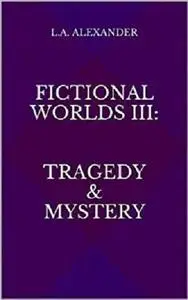Fictional Worlds III: Tragedy & Mystery (Storytelling on Screen) by L.A. Alexander
English | May 4, 2014 | ASIN: B00K57RLLY | 217 pages | AZW3 | 0.37 MB
English | May 4, 2014 | ASIN: B00K57RLLY | 217 pages | AZW3 | 0.37 MB
Fictional Worlds III: Tragedy & Mystery explores our relationships with the Unknown and attraction to mysteries. A guide to writing mystery plays, thrillers and suspense, this book investigates the cultural needs behind these narrative forms. It examines their origins, linked to ritual riddles, and complex connections among such genres as tragedy, crime drama, detective fiction, police procedural, thriller, and film noir.
Employing a range of approaches from the anthropology of storytelling to tips for writing “suspense,” Fictional Worlds III looks into what makes a “perfect mystery,” and its role in culture. What does this spectrum of genres offer society, community and identity-building, as well as our own sense of self? What are the relationships between mystery and knowledge? How do we explore the world by means of crime investigation plays? Who are their typical heroes and villains? What do we know about the “usual suspects,” a familiar cast of characters – the hardboiled detectives, the femme fatale, ruthless killers, sneaky con artists, and a variety of shadowy figures and unreliable witnesses?
What impact on the development of crime drama have its predecessors had: ritual, high tragedy, classical drama, as well as experimentations with narrative form by artists of the Baroque, Romanticism and Expressionism? What are the roots of the phenomenon of “suspense” and its relationships with “pathos”? Is “global noir” the next “big thing” in storytelling? And how do you write for this genre? Featuring the symbolic character of the Private Investigator, this volume examines why this figure is such an important cultural symbol in our era. Hitchcock is highlighted as a visual storyteller who created a synthesis of these traditions to advance the genres of crime investigation.
This text discusses: detective fiction and ritual mythology; who killed the father in The Brothers Karamazov, and why; the cultural origin of the Sherlock Holmes figure and his many descendants in literature and the media; films starring Humphrey Bogart; as well as case studies of Gosford Park (Robert Altman), Road to Perdition (Sam Mendes), and The Departed (Martin Scorsese).
The “accidental” detective of The Big Lebowski will appear in Fictional Worlds IV: Comedy & The Extraordinary, to continue the exploration of these genres’ propensity for self-parody and relations with comedy. The next volume discusses: how mystery pairs with farce to create narrative forms triggering sarcastic laughter; screen mockery of the thriller and suspense clichйs; dark humor stories and the theater of the absurd, particularly in the Coen Brothers’ fictional worlds of horror-farce.
The content of Tragedy & Mystery volume is connected with books I, II and IV of the Fictional Worlds set. (All four books are available under one cover in a print version, titled Fictional Worlds: Traditions in Narrative and the Age of Visual Culture). Fictional Worlds III examines how tragedy and mystery contribute to shaping social behaviors, as part of their specific genre frameworks. This book highlights the fact that the Hero’s Journey, central to the action-adventure genre, is also at the heart of mystery plays; and further develops the conception of the Second Journey as a core theme of storytelling on-screen.
Resonating with Fictional Worlds II, this volume illustrates how both tragedy and mystery relate to drama, and how thriller further complicates the classical dramatic arc. Emphasizing the power of the Unknown, the mechanism of suspense, and the struggle to reveal the truth, the genres of tragedy and mystery remind us that victory is never ensured. This volume’s goal is to help readers understand mystery as a narrative form, and to help writers design intelligent psychological thrillers, which are astonishing, engaging, and socially r



